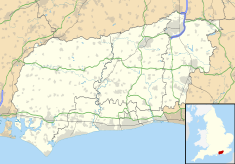Fountain Inn, Ashurst
| Fountain Inn | |
|---|---|

The inn viewed from the south
|
|
| Location | Off Horsham Road, Ashurst, Steyning, West Sussex BN44 3AP, United Kingdom |
| Coordinates | 50°55′58″N 0°19′17″W / 50.9328°N 0.3215°WCoordinates: 50°55′58″N 0°19′17″W / 50.9328°N 0.3215°W |
| Built | 16th century |
| Restored | Early 19th century |
| Architectural style(s) | Georgian |
|
Listed Building – Grade II
|
|
| Official name: The Fountain Inn | |
| Designated | 9 May 1980 |
| Reference no. | 298322 |
The Fountain Inn is a 16th-century public house in the village of Ashurst, in the Horsham district of West Sussex, England. After a period as a farmhouse, it was converted into the village inn and was extended and given a Georgian façade in the 18th century. English Heritage has listed the building at Grade II for its architectural and historical importance.
Ashurst is a small village and civil parish about 3 miles (5 km) north of the town of Steyning. The parish covers a large area (2,494 acres (1,009 ha)) and consists mostly of well-spaced farms and other scattered buildings, but a small settlement had developed around the Horsham—Steyning road by the early 16th century. Many of the present buildings are 16th-century, although in some cases they replaced older buildings. Development spread along the road in the 17th century.
The first inn in the parish was to the south of the main settlement, near Horsebridge Common. It existed by the 17th century and over time was known by at least three names, the last of which was The Fountain. The building occupied by the present inn of that name was one of several timber-framed, partly tile-hung farmhouses in the centre of the village, opposite the village pond. It became an inn under the sign of the Red Lion by 1788, and adopted the name Fountain Inn soon afterwards.
In the early 19th century, the building was extended: an extra wing was added on the north side, perpendicular to the original structure, in brick. In contrast to the tiled roof of the older part, the newer wing had a roof of slate. At the same time, the façade was altered from its original timber-framed appearance: the Georgian style, popular at the time, was adopted.
...
Wikipedia

